人教高中英语必修四Unit 4 Body language v-ing形式作状语课件(33张PPT)
文档属性
| 名称 | 人教高中英语必修四Unit 4 Body language v-ing形式作状语课件(33张PPT) |  | |
| 格式 | zip | ||
| 文件大小 | 1.4MB | ||
| 资源类型 | 教案 | ||
| 版本资源 | 人教版(新课程标准) | ||
| 科目 | 英语 | ||
| 更新时间 | 2019-06-30 19:36:40 | ||
图片预览


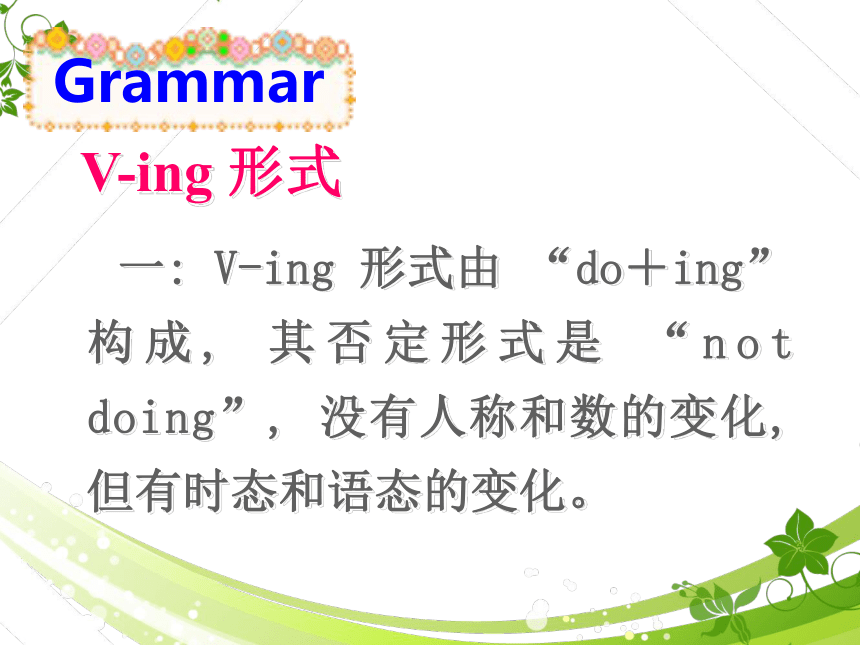
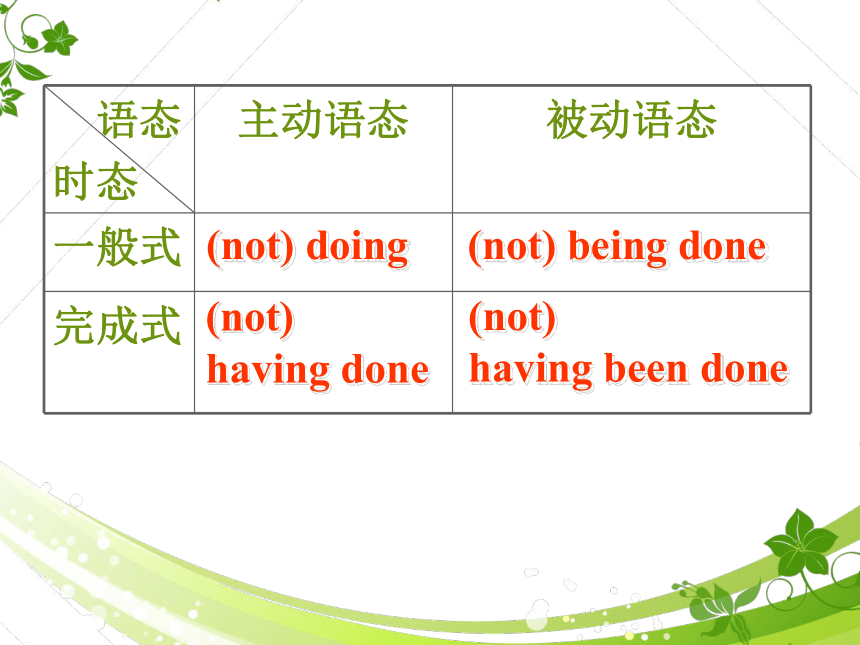
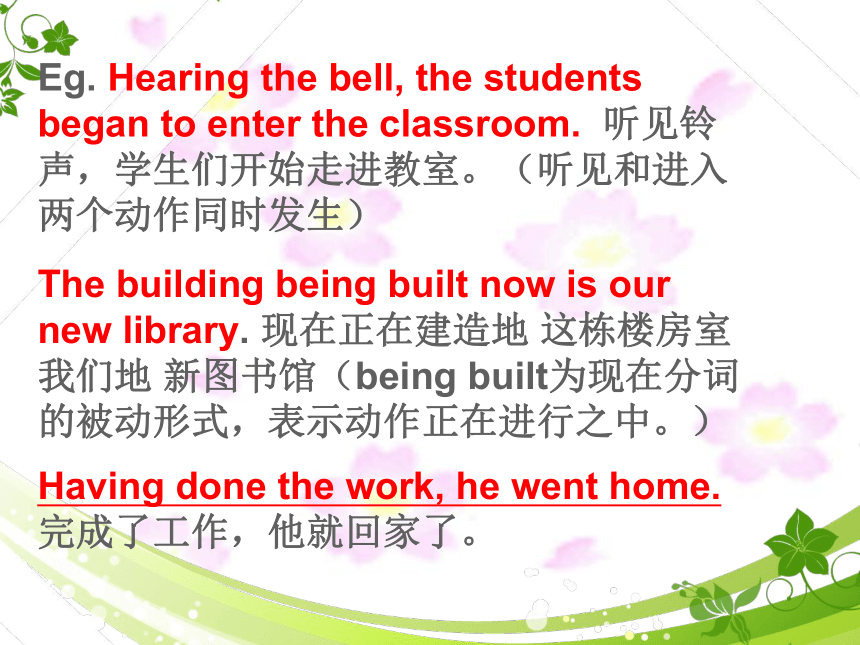
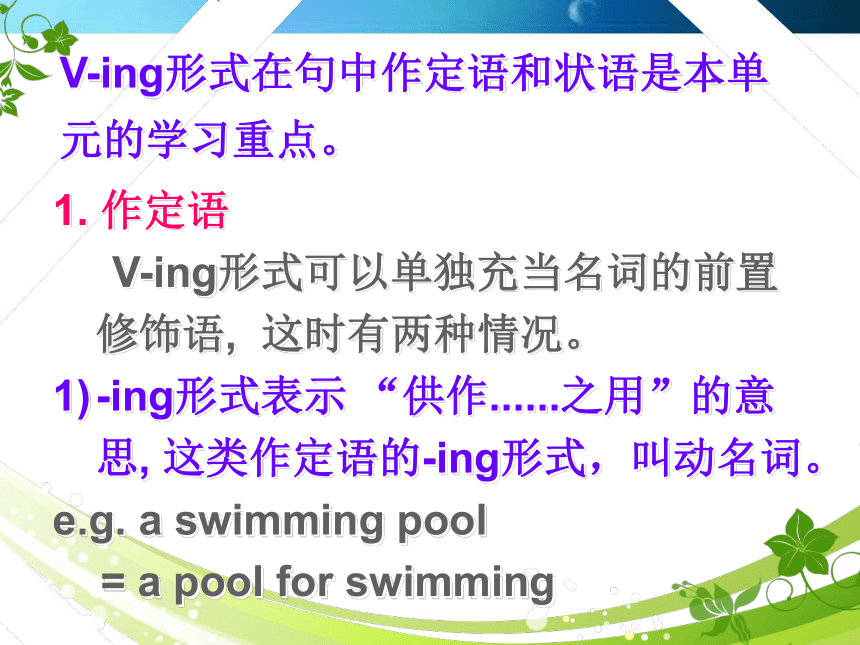
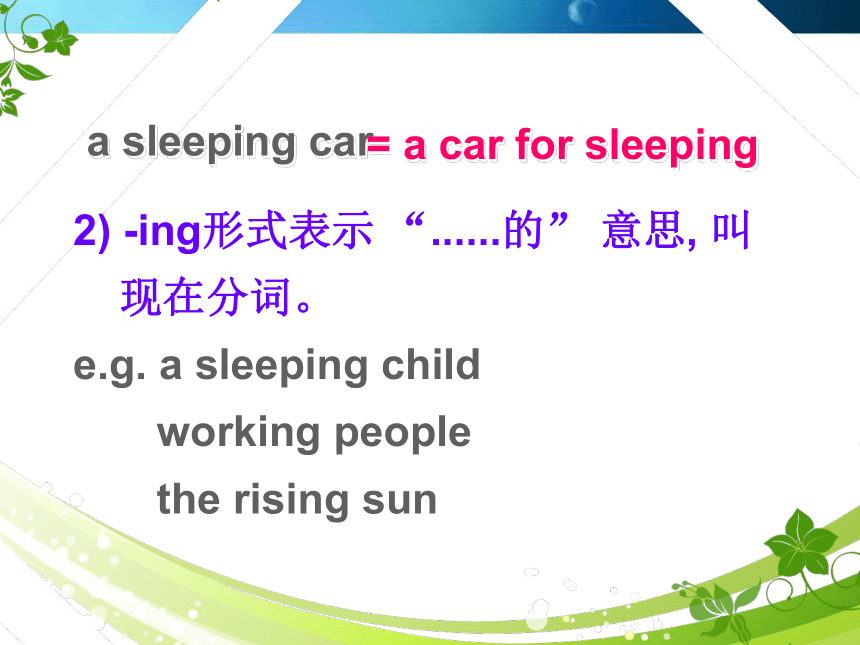
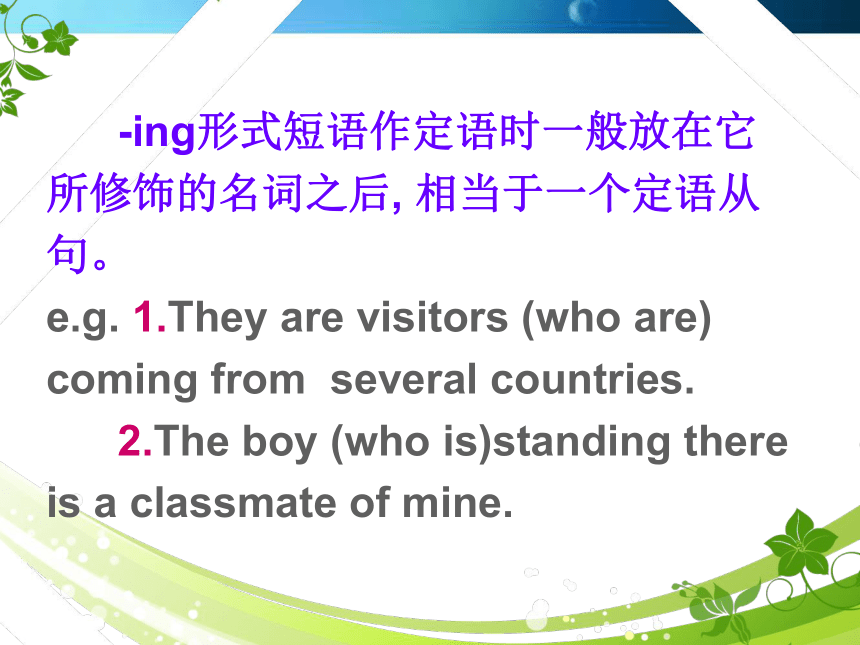
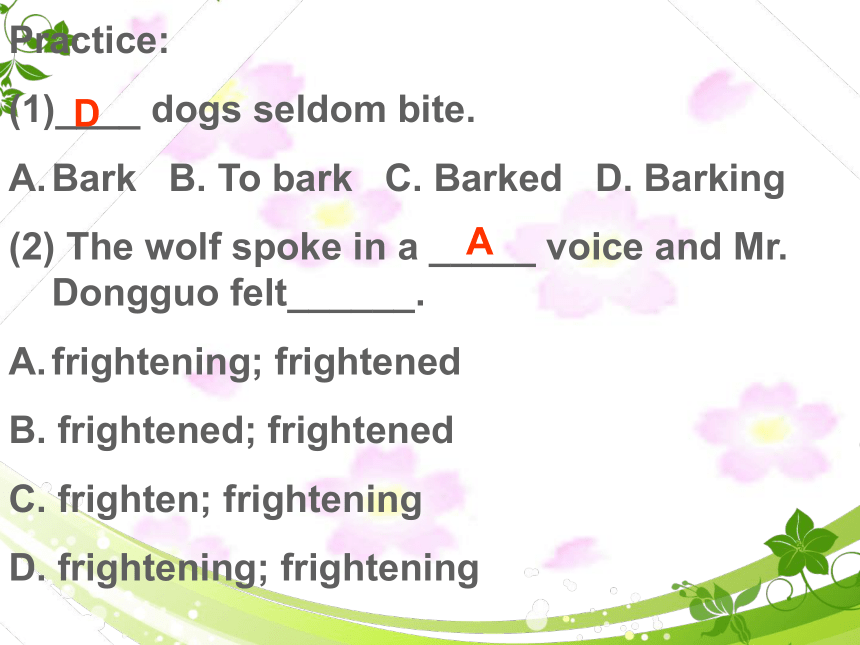

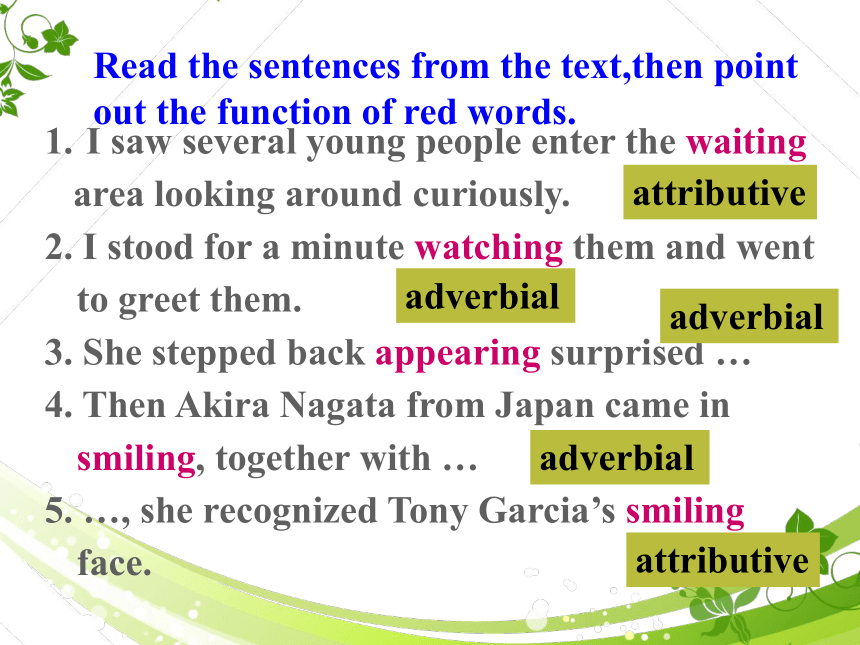

文档简介
(共33张PPT)
一: V-ing 形式由 “do+ing” 构成, 其否定形式是 “not doing”, 没有人称和数的变化, 但有时态和语态的变化。
Grammar
V-ing 形式
(not) doing
(not) being done
(not)
having done
(not)
having been done
语态
时态 主动语态 被动语态
一般式
完成式
Eg. Hearing the bell, the students began to enter the classroom. 听见铃声,学生们开始走进教室。(听见和进入两个动作同时发生)
The building being built now is our new library. 现在正在建造地 这栋楼房室我们地 新图书馆(being built为现在分词的被动形式,表示动作正在进行之中。)
Having done the work, he went home. 完成了工作,他就回家了。
V-ing形式在句中作定语和状语是本单元的学习重点。
1. 作定语
V-ing形式可以单独充当名词的前置修饰语, 这时有两种情况。
-ing形式表示 “供作......之用”的意思, 这类作定语的-ing形式,叫动名词。
e.g. a swimming pool
= a pool for swimming
a sleeping car
= a car for sleeping
2) -ing形式表示 “......的” 意思, 叫现在分词。
e.g. a sleeping child
working people
the rising sun
-ing形式短语作定语时一般放在它所修饰的名词之后, 相当于一个定语从句。
e.g. 1.They are visitors (who are) coming from several countries.
2.The boy (who is)standing there is a classmate of mine.
Practice:
____ dogs seldom bite.
Bark B. To bark C. Barked D. Barking
(2) The wolf spoke in a _____ voice and Mr. Dongguo felt______.
frightening; frightened
B. frightened; frightened
C. frighten; frightening
D. frightening; frightening
D
A
(3) It’s pleasure to watch the face of a ____ baby.
asleep B. sleep C. sleeping D. slept
(4) The ____ buildings showed us that an earthquake was coming.
A. shaking B. shook C. shaken D. shake
C
A
Read the sentences from the text,then point out the function of red words.
I saw several young people enter the waiting
area looking around curiously.
2. I stood for a minute watching them and went to greet them.
3. She stepped back appearing surprised …
4. Then Akira Nagata from Japan came in smiling, together with …
5. …, she recognized Tony Garcia’s smiling face.
attributive
adverbial
adverbial
adverbial
attributive
二、-ing形式作状语
-ing短语在句子中可作状语,来修饰谓语动词或整个句子,表示动作发生的时间、原因、条件、结果、让步或伴随等情况。-ing短语作状语一般表示一个次要的动作, 一般都可以变为相应的状语从句或并列句。
1. 作时间状语
-ing短语作时间状语要置于句首。如:
Hearing the bad news, they couldn’t help crying.
=When they heard the bad news, they couldn’t help crying. 当听到这个不幸的消息时,他们情不自禁地哭了起来。
Having received his letter, I decided to write back. =After I had received his letter, I decided to write back. 收到他的信后,我决定给他回信。
2. 作原因状语
-ing短语作原因状语置于句首。如:
Being so angry, he couldn’t go to sleep.
=Because he was so angry, he couldn’t go to sleep. 因为太生气了,他不能入睡。
Having been to the Great Wall many times, he didn’t go last week. =Because (As) he had been to the Great Wall many times, he didn’t go last week. 因为他已经去过长城许多次,上周他就没去。
3. 作条件状语
-ing作条件状语置于句首或句末。如:
Working hard, you will succeed. =If you work hard, you will succeed. 如果你勤奋一点,你就会成功。
Being given more attention, the trees could have grown better.
=If they had been given more attention, the trees could have grown better. 如果对这些树再多注意些,它们可能长得更好。
4. 作让步状语
-ing短语作让步状语,可置于句首或 句末,常与even if, though 连用。如:
Though working from morning till night, his father didn’t get enough food.
=Although his father worked from morning till night, he didn’t get enough food.
虽然他父亲从早到晚拼命地干活,但是他还是挣不到足够的吃的。
5. 作伴随状语
置于句首或句末。如:
They came into the classroom, singing and laughing. =They sang and laughed; they came into the classroom. 他们又唱又笑地走进教室。
When working in the factory, he was
an advanced worker.
=When he worked in the factory, he
was an advanced worker.
注意:
1. -ing短语与when, while, though, until, if等连词连用时,相当于这些连词引导的一个从句。如:
Though willing to attend the party, he
refused the invitation.
=Though he was willing to attend the
party, he refused the invitation.
While staying in Beijing, he came to see
me twice.
=While he was staying in Beijing, he
came to see me twice.
If playing all day, you will waste
your valuable time.
=If you play all day, you will waste
your valuable time.
Though raining heavily, it cleared up very soon.
=Though it was raining heavily, it
cleared up very soon.
注意:
2.现在分词作状语时,其逻辑主语必须与主句中主语一致。它们之间是主动关系。被动则用V-ed.
但是短语 generally speaking; judging from/by; compared with等是固定搭配。不受主语影响。
Judging from his face,he was very angry.
The man came in, followed by a little boy.
1. a. Hearing the news, tears ran down her face.
b. Hearing the news, she cried out sadly.
2. a. Entering the classroom, I found nobody in it.
b. Entering the classroom, nobody was found in it.
Choose the correct sentence.
3. a. Looking out through the window, the garden was beautiful.
b. Looking out through the window, we saw a beautiful garden.
4. a. Reading the evening newspaper, a dog started barking.
b. I was reading the evening newspaper when a dog started barking.
5. a. Being fine, we will have the sports meeting next week.
b. It being fine, we will have the sports meeting next week.
-ing形式的否定式为在其前面加not。
如:
He sat there, not knowing what to say.
1. Having not seen the film, I can’t tell you what I think of it.
2. The men worked for extra hours got an extra pay.
3. Seen from the top of the hill, we find the city more beautiful.
4. Generally speak, facial expressions are helpful communications, too.
Not having
working
Seeing
speaking
单句改错
1. Their car was caught in a traffic jam, thus____ the delay.
A. to cause B. causing
C. caused D. cause
2. One by one Peter sold his bits and pieces, ____ only a mite of their worth. A. getting B. got C. to get D. get
Exercise
3. After seeing the movie, _____. A. the book was read by him
B. the book made him want to read it C. he wanted to read the book D. the reading of the book interested
him
Attention
3. -ing形式作状语时, 它的逻辑主语必须与主句的主语是一致的。
e.g. Time permitting, I will pay a visit to the whole city.
(分词的逻辑主语是time, 而句子的主语是I, 两者不构成主谓关系, 所以只能用独立主格结构, 也就是给现在分词补充一个主语。)
e.g.
I waiting for the bus, a bird fell on my heard.
我等汽车时,一只鸟落到我头上。
All the tickets having been sold out, they went away disappointedly.
所有的票已经卖光了,他们失望地离开了。
Time permitting, we’ll do another two exercises.
如果时间允许,我们将做另两个练习。
AAAttdddAttention
4.有时也可用with (without)+名词(代词宾格)+分词形式
e.g. With the lights burning, he fell
asleep.
他点着灯睡着了。
一: V-ing 形式由 “do+ing” 构成, 其否定形式是 “not doing”, 没有人称和数的变化, 但有时态和语态的变化。
Grammar
V-ing 形式
(not) doing
(not) being done
(not)
having done
(not)
having been done
语态
时态 主动语态 被动语态
一般式
完成式
Eg. Hearing the bell, the students began to enter the classroom. 听见铃声,学生们开始走进教室。(听见和进入两个动作同时发生)
The building being built now is our new library. 现在正在建造地 这栋楼房室我们地 新图书馆(being built为现在分词的被动形式,表示动作正在进行之中。)
Having done the work, he went home. 完成了工作,他就回家了。
V-ing形式在句中作定语和状语是本单元的学习重点。
1. 作定语
V-ing形式可以单独充当名词的前置修饰语, 这时有两种情况。
-ing形式表示 “供作......之用”的意思, 这类作定语的-ing形式,叫动名词。
e.g. a swimming pool
= a pool for swimming
a sleeping car
= a car for sleeping
2) -ing形式表示 “......的” 意思, 叫现在分词。
e.g. a sleeping child
working people
the rising sun
-ing形式短语作定语时一般放在它所修饰的名词之后, 相当于一个定语从句。
e.g. 1.They are visitors (who are) coming from several countries.
2.The boy (who is)standing there is a classmate of mine.
Practice:
____ dogs seldom bite.
Bark B. To bark C. Barked D. Barking
(2) The wolf spoke in a _____ voice and Mr. Dongguo felt______.
frightening; frightened
B. frightened; frightened
C. frighten; frightening
D. frightening; frightening
D
A
(3) It’s pleasure to watch the face of a ____ baby.
asleep B. sleep C. sleeping D. slept
(4) The ____ buildings showed us that an earthquake was coming.
A. shaking B. shook C. shaken D. shake
C
A
Read the sentences from the text,then point out the function of red words.
I saw several young people enter the waiting
area looking around curiously.
2. I stood for a minute watching them and went to greet them.
3. She stepped back appearing surprised …
4. Then Akira Nagata from Japan came in smiling, together with …
5. …, she recognized Tony Garcia’s smiling face.
attributive
adverbial
adverbial
adverbial
attributive
二、-ing形式作状语
-ing短语在句子中可作状语,来修饰谓语动词或整个句子,表示动作发生的时间、原因、条件、结果、让步或伴随等情况。-ing短语作状语一般表示一个次要的动作, 一般都可以变为相应的状语从句或并列句。
1. 作时间状语
-ing短语作时间状语要置于句首。如:
Hearing the bad news, they couldn’t help crying.
=When they heard the bad news, they couldn’t help crying. 当听到这个不幸的消息时,他们情不自禁地哭了起来。
Having received his letter, I decided to write back. =After I had received his letter, I decided to write back. 收到他的信后,我决定给他回信。
2. 作原因状语
-ing短语作原因状语置于句首。如:
Being so angry, he couldn’t go to sleep.
=Because he was so angry, he couldn’t go to sleep. 因为太生气了,他不能入睡。
Having been to the Great Wall many times, he didn’t go last week. =Because (As) he had been to the Great Wall many times, he didn’t go last week. 因为他已经去过长城许多次,上周他就没去。
3. 作条件状语
-ing作条件状语置于句首或句末。如:
Working hard, you will succeed. =If you work hard, you will succeed. 如果你勤奋一点,你就会成功。
Being given more attention, the trees could have grown better.
=If they had been given more attention, the trees could have grown better. 如果对这些树再多注意些,它们可能长得更好。
4. 作让步状语
-ing短语作让步状语,可置于句首或 句末,常与even if, though 连用。如:
Though working from morning till night, his father didn’t get enough food.
=Although his father worked from morning till night, he didn’t get enough food.
虽然他父亲从早到晚拼命地干活,但是他还是挣不到足够的吃的。
5. 作伴随状语
置于句首或句末。如:
They came into the classroom, singing and laughing. =They sang and laughed; they came into the classroom. 他们又唱又笑地走进教室。
When working in the factory, he was
an advanced worker.
=When he worked in the factory, he
was an advanced worker.
注意:
1. -ing短语与when, while, though, until, if等连词连用时,相当于这些连词引导的一个从句。如:
Though willing to attend the party, he
refused the invitation.
=Though he was willing to attend the
party, he refused the invitation.
While staying in Beijing, he came to see
me twice.
=While he was staying in Beijing, he
came to see me twice.
If playing all day, you will waste
your valuable time.
=If you play all day, you will waste
your valuable time.
Though raining heavily, it cleared up very soon.
=Though it was raining heavily, it
cleared up very soon.
注意:
2.现在分词作状语时,其逻辑主语必须与主句中主语一致。它们之间是主动关系。被动则用V-ed.
但是短语 generally speaking; judging from/by; compared with等是固定搭配。不受主语影响。
Judging from his face,he was very angry.
The man came in, followed by a little boy.
1. a. Hearing the news, tears ran down her face.
b. Hearing the news, she cried out sadly.
2. a. Entering the classroom, I found nobody in it.
b. Entering the classroom, nobody was found in it.
Choose the correct sentence.
3. a. Looking out through the window, the garden was beautiful.
b. Looking out through the window, we saw a beautiful garden.
4. a. Reading the evening newspaper, a dog started barking.
b. I was reading the evening newspaper when a dog started barking.
5. a. Being fine, we will have the sports meeting next week.
b. It being fine, we will have the sports meeting next week.
-ing形式的否定式为在其前面加not。
如:
He sat there, not knowing what to say.
1. Having not seen the film, I can’t tell you what I think of it.
2. The men worked for extra hours got an extra pay.
3. Seen from the top of the hill, we find the city more beautiful.
4. Generally speak, facial expressions are helpful communications, too.
Not having
working
Seeing
speaking
单句改错
1. Their car was caught in a traffic jam, thus____ the delay.
A. to cause B. causing
C. caused D. cause
2. One by one Peter sold his bits and pieces, ____ only a mite of their worth. A. getting B. got C. to get D. get
Exercise
3. After seeing the movie, _____. A. the book was read by him
B. the book made him want to read it C. he wanted to read the book D. the reading of the book interested
him
Attention
3. -ing形式作状语时, 它的逻辑主语必须与主句的主语是一致的。
e.g. Time permitting, I will pay a visit to the whole city.
(分词的逻辑主语是time, 而句子的主语是I, 两者不构成主谓关系, 所以只能用独立主格结构, 也就是给现在分词补充一个主语。)
e.g.
I waiting for the bus, a bird fell on my heard.
我等汽车时,一只鸟落到我头上。
All the tickets having been sold out, they went away disappointedly.
所有的票已经卖光了,他们失望地离开了。
Time permitting, we’ll do another two exercises.
如果时间允许,我们将做另两个练习。
AAAttdddAttention
4.有时也可用with (without)+名词(代词宾格)+分词形式
e.g. With the lights burning, he fell
asleep.
他点着灯睡着了。
同课章节目录
